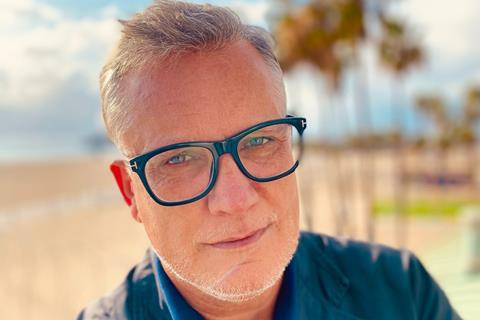
Challenges to the pre-sales model, theatrical distribution and talent availability have painted a gloomy picture of the independent space. The reality, argues AGC Studios chairman and CEO Stuart Ford, is more nuanced and positive for those who stay disciplined and seize opportunity. AGC is at AFM launching Joel Kinnaman thriller The Silent Hour.
What’s your overall take on the independent space?
There are green shoots of recovery, but the indie film financing business is still beset with challenges. Ongoing heavy Covid contingency and protocol costs, additional bond fees, higher banking costs, limited US theatrical options and a soft foreign sales market are all potential roadblocks to traditional financing structures.
Nevertheless, that model’s still currently viable for well-packaged projects, budgeted at the right level, presented to the marketplace in the right way and with meaningful equity backing. The latter is key because with Asian buyers barely back in the game and major distributors in Europe and the rest of the world wrestling with a strong dollar exchange rate and their own local box office fragilities, financiers have to stay clear-eyed over foreign pre-sales expectations.
Cannes was a dumpster fire, an onslaught of either previously stalled projects or newer but poorly conceived packages rushing back to market mostly with unrealistic expectations. Unsurprisingly, the buyers’ biggest complaint coming into AFM is how few of all those Cannes packages have actually gone into production. That’s bad for buyer confidence and I think lessons have to be learned.
How are these ongoing challenges affecting the kind of films getting made?
The biggest victim is the $30m-plus mid-budget action film, which for so long has been a market driver. Although US theatrical distributors had in recent years started paying smaller advances for these films as a trade-off for committing wide release P&A funding, that portion of the bigger indie budgets had increasingly been filled by equity backing out of economies like China, Russia and the Middle East. But most of that overseas equity backing has dried up for the moment, plus the circle of US distributors looking to source wide theatrical movies from the independent sector has shrunk further. That makes most projects of that budget unfinanceable and it’s noticeable at AFM how those noisy action films are largely absent.
How did AGC stay productive during the pandemic?
Like many others, we were frustrated by several heavily pre-sold movies falling apart due to talent unavailability or other Covid challenges. So in fall 2021, we decided to reboot our short-term indie film strategy to focus essentially on more modest sub-$20m budgets, to use our own capital aligned with reliable partners to bolster the equity component of the budgets and avoid launching anything too far away from a production start. The result has been that every one of the half-dozen projects we brought to market in the past 12 months is in production or completed and I know that the international buyers appreciate that degree of reliability and our insistence on always having real skin in the game.
Fortunately, AGC has thriving scripted TV and non-fiction businesses to help offset the slightly reduced budgetary ambitions on our film side. The company is in formal pre-production on the $140m Roland Emmerich TV series Those About To Die and enjoyed a global hit with documentary The Tinder Swindler on Netflix. We still love bigger films and AGC has been a proud partner on all four of the $100m-plus budgeted independent films made since we launched. But we’re content to meet the moment in the industry and for now focus on reliably hitting singles and doubles with our partners until there’s a more expansive market rebound.

How do you see streamer activity impacting independents?
As much as the streamer money has boosted film and TV production levels around the world, I see the shifts in strategy and in some cases reduction of production outlay among the big platforms as positive signs towards the revival of independent film. That drives more talent and material back to the indie space. Both the Richard Linklater film Hitman and the Anna Kendrick film The Dating Game that we’re currently in production on were packages that fell out of the streaming universe earlier in the year. I also sense that certain platforms are returning to a more flexible production model rather than the “pay for it all and own everything” approach. That creates more split rights and co-financing opportunities for well-capitalised indie studios.
Do in-person markets still matter?
The novelty of virtual markets soon wore off — buyers and sellers found them to be a soulless grind. Deals can still be negotiated over Zoom and email but the independent distribution sector functions best when worldwide players gather to screen films together, attend presentations, review marketing materials, exchange industry information and forge relationships. AFM, EFM, Cannes Marché and Toronto are essential to the health of the industry and they’re not going away, although nobody needs a market that lasts more than four to five days, like this AFM. I hope that becomes the new normal.
How do you feel looking ahead?
The future of the independent film business is aligned to the future of theatrical. That’s not to say that there isn’t room in the marketplace for a healthy balance of traditional distributors and streaming buyers, or that we aren’t seeing overdue acknowledgement from international distributors that US theatrical profile isn’t the be all and end all for a movie’s overseas prospects. But international sales is the biggest single component of the indie financing model and these distributors overseas need to consistently release films theatrically in their own markets for their P&L’s to generate the right margins.
I’m bullish on the future. These COVID costs will eventually phase out. The talent is coming back to indie film. Box office will grow. Distributors have become more flexible and sophisticated over where and when a film plays theatrically outside of their home territory so financiers can increasingly access both foreign pre-sales and streamer money. If the production outlay of the streamers continues to scale back, those platforms will likely place more emphasis on acquiring third party financed product and that’ll be healthy both for Hollywood financiers and for international distributors looking to maximize the post-theatrical value of their acquisitions. This will all make the model more effective.
We still need to move towards a leaner, more disciplined indie film sector. The faster that reset continues the sooner that institutional capital will start to flood back into independent film as an asset class and I think there’ll be significant opportunity for the financiers and the distributors currently keeping this AFM lively and for new entrants.
























No comments yet